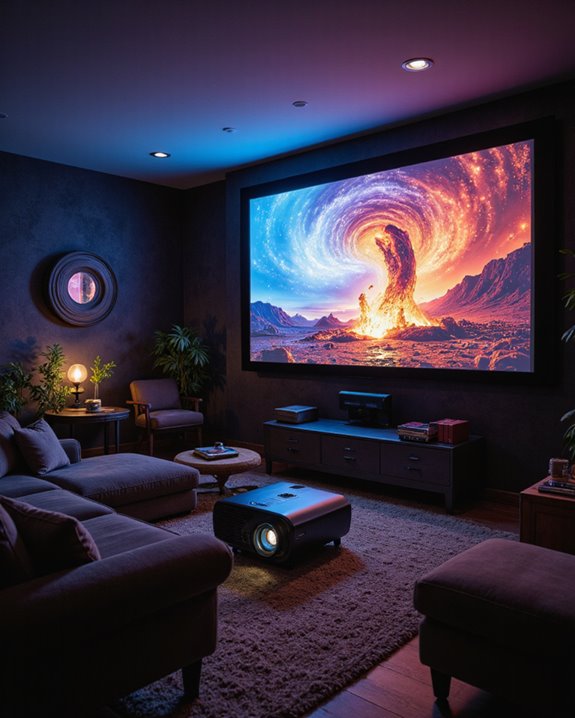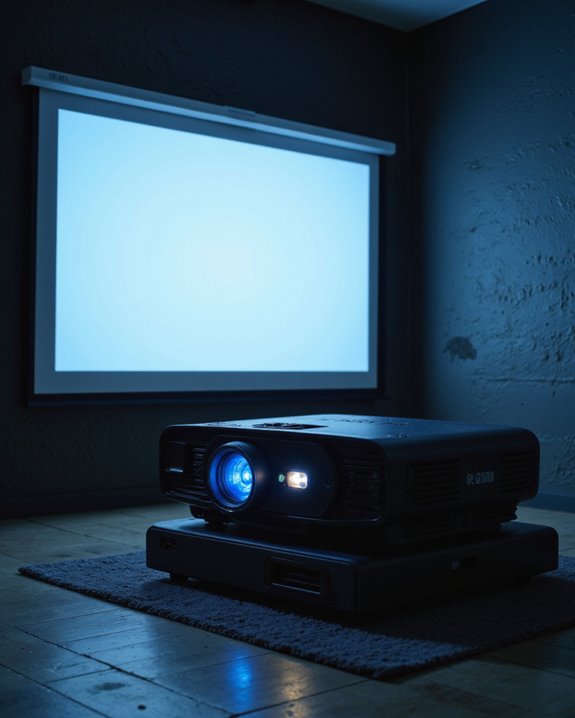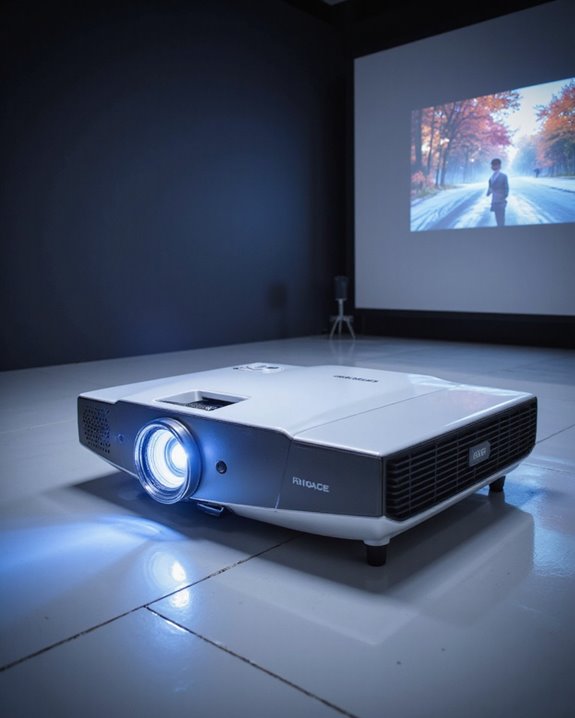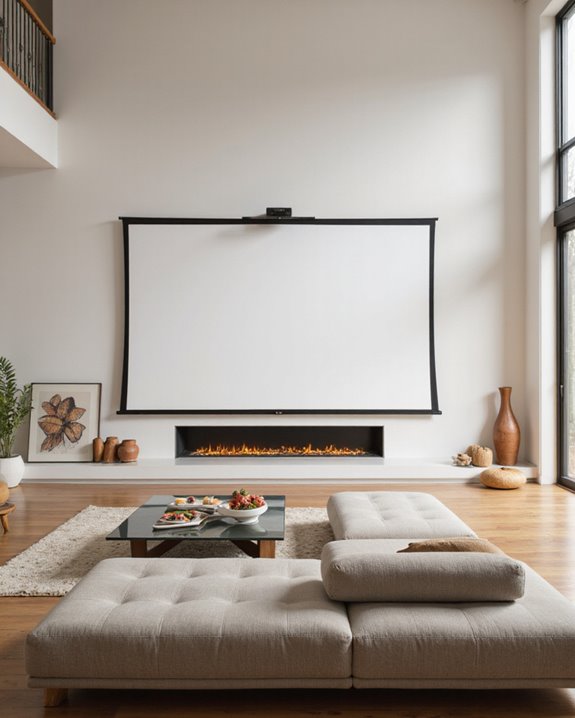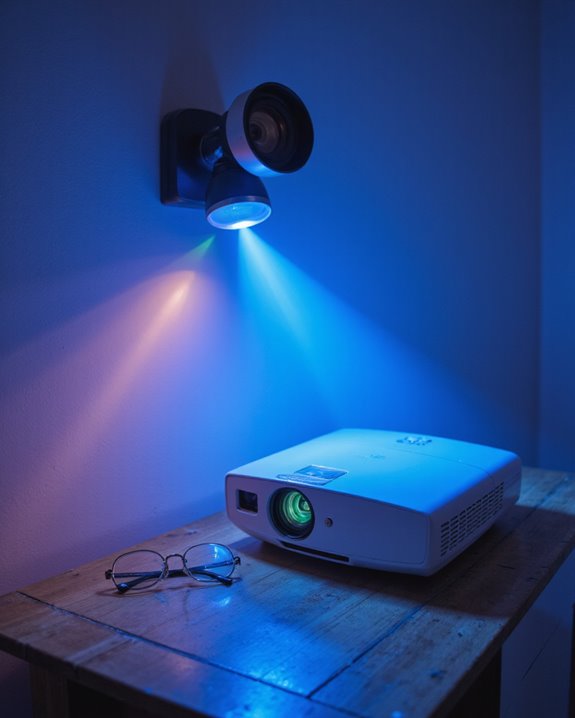Modern home theater projectors offer significant advantages over traditional TVs, delivering cinema-quality experiences at lower costs per screen inch. These devices provide adjustable screen sizes up to 120 inches, superior viewing flexibility, and reduced eye strain through natural light reflection. Advanced features like ultra-short throw technology and laser light sources enable versatile placement options in any room size. The growing market trends and technological improvements continue to enhance the home entertainment experience in unexpected ways.
Key Takeaways
- Projectors deliver larger screen sizes (100-120 inches) at a lower cost per inch compared to traditional TVs, offering better value.
- Ultra-short throw technology enables immersive home theater experiences even in small spaces, with flexible placement options.
- Advanced features like laser light sources provide up to 20,000 hours of maintenance-free operation and superior image quality.
- Adjustable screen sizes and viewing angles reduce eye strain while creating a more natural, theater-like viewing experience.
- Portable designs and versatile projection capabilities allow seamless transitions between indoor and outdoor entertainment spaces.
The Immersive Cinema Experience at Home
Why are more homeowners transforming their living rooms into private cinemas? The growing demand for immersive home theater experiences reflects a significant market shift, with projector sales expected to reach USD 10.1 billion by 2033. This surge stems from consumers seeking enhanced visual storytelling and cinematic realism in their homes.
Recent technological advancements in projection systems have revolutionized home viewing. Three main technologies – DLP (Digital Light Processing), LCD (Liquid Crystal Display), and LCoS (Liquid Crystal on Silicon) – offer viewers different options for achieving theater-quality experiences. These systems deliver superior image quality while providing setup flexibility, allowing homeowners to create customized viewing spaces on various surfaces. The ultra-short throw projectors are particularly popular, dominating 53.3% of the market share due to their ability to produce large images from close distances. Additionally, the advent of high brightness projectors enables use even in well-lit rooms, further expanding their applications within home settings.
The transformation toward home theaters also aligns with changing lifestyle preferences, as more people seek professional-grade entertainment solutions within their living spaces.
Cost Benefits of Choosing a Projector
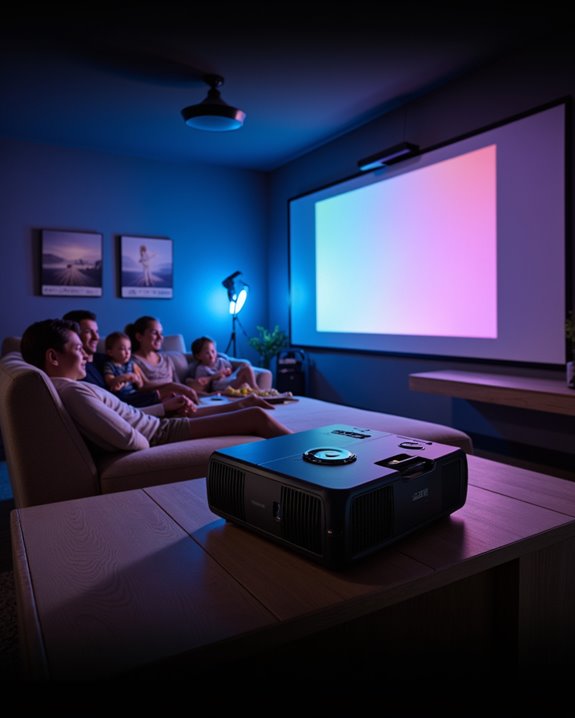
Three key financial advantages make projectors an attractive choice for home theater enthusiasts. First, projectors deliver larger screen sizes at a lower cost than comparable TVs, with quality options available for under $1,000. Second, budget options span from affordable entry-level models to premium units, allowing buyers to match their investment to their needs. These versatile devices offer cost per screen-inch advantages that significantly outperform traditional television options.
The long-term cost benefits are equally compelling. Maintenance costs remain manageable through replaceable components like lamps, eliminating the need for complete system upgrades. Additionally, projectors often consume less energy than large-format TVs, particularly in controlled lighting environments. The BenQ HT2060 exemplifies this value proposition, offering theater-quality performance at a fraction of the cost of premium televisions while providing years of reliable service through simple maintenance procedures.
Customizable Screen Sizes and Viewing Flexibility
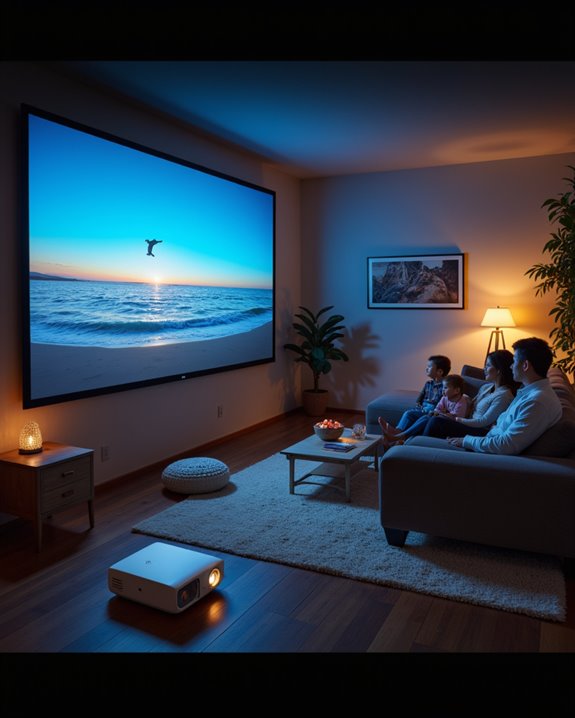
While cost considerations guide many home theater decisions, the remarkable versatility of projector systems opens up new possibilities for customizable viewing experiences. Screen customization allows viewers to adjust display sizes from 100 to 120 inches diagonally, far exceeding typical TV dimensions. When setting up projector screens, experts recommend maintaining a 30-degree viewing angle for optimal immersion and visual comfort. Additionally, modern projectors utilize advanced heat management techniques like heat pipes and noise-reduction fans to ensure quiet operation during extended viewing sessions. The aspect ratio flexibility of projectors proves especially valuable, accommodating various content formats. Viewers can easily switch between 16:9 for regular TV shows and 2.35:1 for widescreen movies, eliminating awkward black bars on screen. Modern projectors offer features like keystone correction, which prevents image distortion when mounting at different angles, and lens shift capabilities for precise screen positioning. These adjustments, combined with multiple mounting options and screen material choices, ensure ideal viewing in various room layouts and lighting conditions.
Eye Health and Viewing Comfort
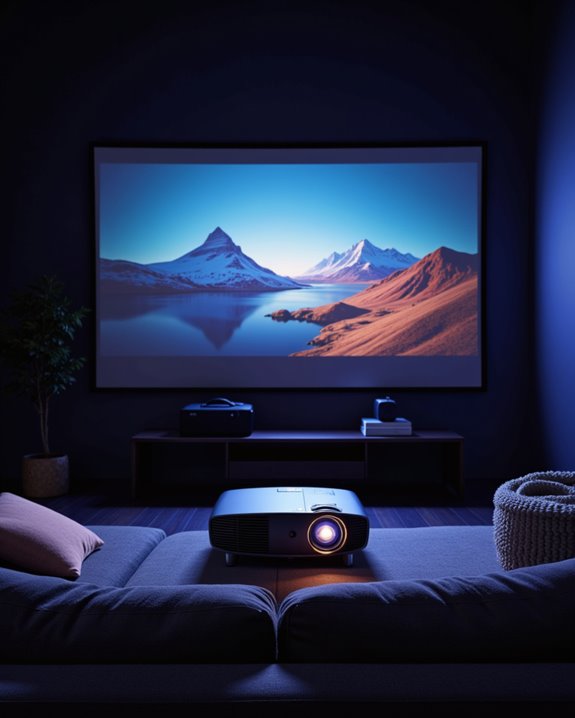
Modern projector systems offer significant advantages for eye health and viewing comfort compared to traditional displays. The larger viewing area reduces eye strain by creating a more natural viewing experience that better matches how humans naturally see. The increased viewing distance allows eyes to remain in a relaxed state, while blue light reduction helps prevent eye fatigue and potential sleep disruptions. Additionally, some models incorporate blue light filtering technology to further protect your eyes during extended use. The indirect light from projectors provides another key benefit for eye health. Unlike direct light from TVs and monitors, projected images reflect off the screen first, reducing the intensity of light reaching the eyes. This gentler approach to illumination, combined with flexible viewing distances of three meters or more, creates a more comfortable viewing environment. The result is a viewing experience that can be sustained for longer periods without discomfort. TÜV SÜsD certification ensures that modern projectors meet strict eye protection standards for safe, extended viewing sessions.
Space-Saving Benefits and Portability
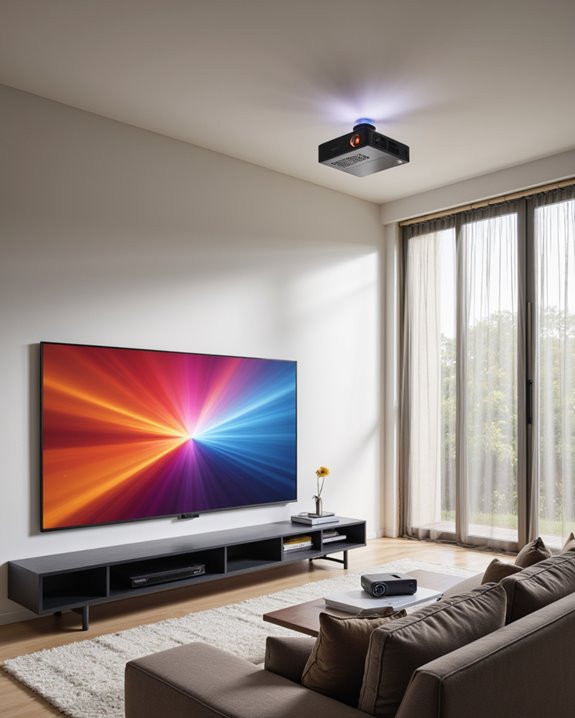
Space constraints in modern homes make projectors an increasingly attractive entertainment solution. Their compact design aesthetics allow for versatile room arrangements while maintaining energy efficiency through minimal space usage. Modern projectors, especially short throw and ultra-short throw models, can create large displays without requiring extensive room depth.
The portability of contemporary projectors offers significant advantages over traditional TVs. Users can easily store these devices when not in use, preventing permanent space dedication to entertainment equipment. This flexibility proves particularly valuable in small apartments or multi-purpose rooms. Rear projection screens further enhance space efficiency by eliminating the need for ceiling mounts or central room placement. These space-saving benefits, combined with the ability to create large viewing areas, make projectors an ideal choice for home theaters of any size. The ability to position screens against walls or corners maximizes available space while maintaining optimal viewing quality.
Advanced Technologies Behind Modern Projectors
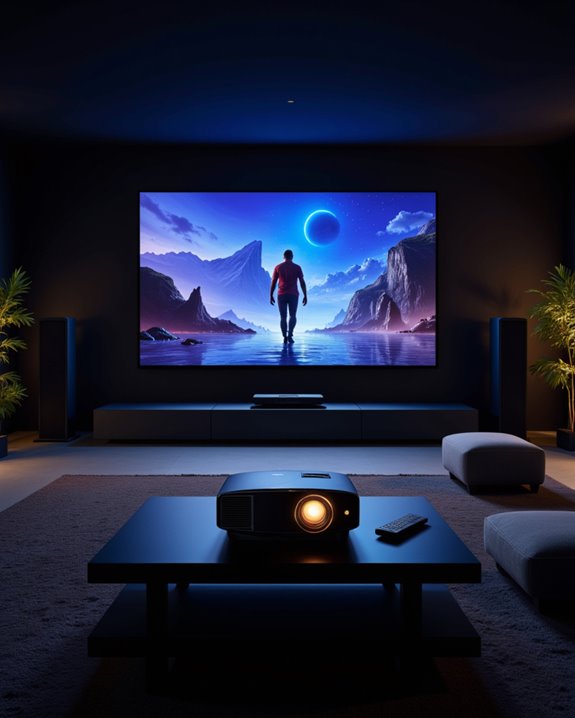
Technological advancements in projector systems have revolutionized home theater experiences through sophisticated features and enhanced performance capabilities. Modern projectors now integrate native 4K resolution with laser light sources, delivering crystal-clear images and improved color accuracy that rivals premium televisions. These systems utilize advanced projection calibration techniques to ensure consistent performance across various content types. Ultra-short-throw technology enables viewers to enjoy immersive 8K displays from just inches away from the screen.
AI-powered processors automatically adjust display settings based on ambient lighting conditions, while high-end laser technology offers up to 20,000 hours of maintenance-free operation. The integration of smart features enables voice control and seamless streaming capabilities. Enhanced connectivity options, including HDMI 2.1 and Wi-Fi 6, support high-bandwidth applications like gaming and 4K streaming. When paired with ALR screens, these projectors can deliver exceptional picture quality even in well-lit rooms, making them versatile for any viewing environment.
Home Entertainment System Integration
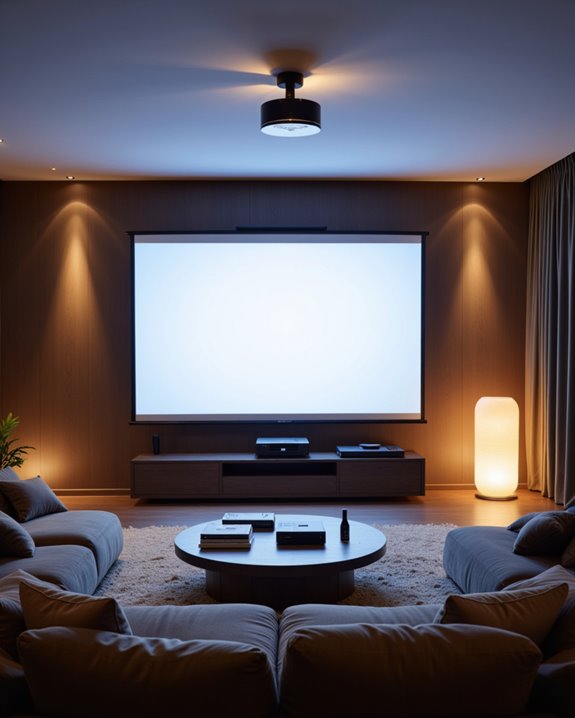
Building upon the advanced capabilities of modern projectors, a complete home entertainment system requires careful integration of multiple components working together seamlessly. The projector must be synchronized with audio equipment, control systems, and source devices to create an ideal viewing experience.
Proper audio calibration ensures that sound perfectly matches the projected image, while room acoustics play a vital role in delivering immersive audio performance. Integration software helps manage these components efficiently, allowing users to control everything from a single interface. Key elements of successful integration include:
- Synchronized audio and video processing through receivers
- Automated lighting and screen controls
- Smart device connectivity for streamlined operation
- Proper cable management for clean installation
- Strategic placement of speakers and subwoofers for balanced sound distribution
This systematic approach transforms individual components into a cohesive entertainment system. A properly installed surge protector safeguards all connected devices against unexpected power fluctuations that could damage the integrated system.
The Growing Market for Home Theater Projectors
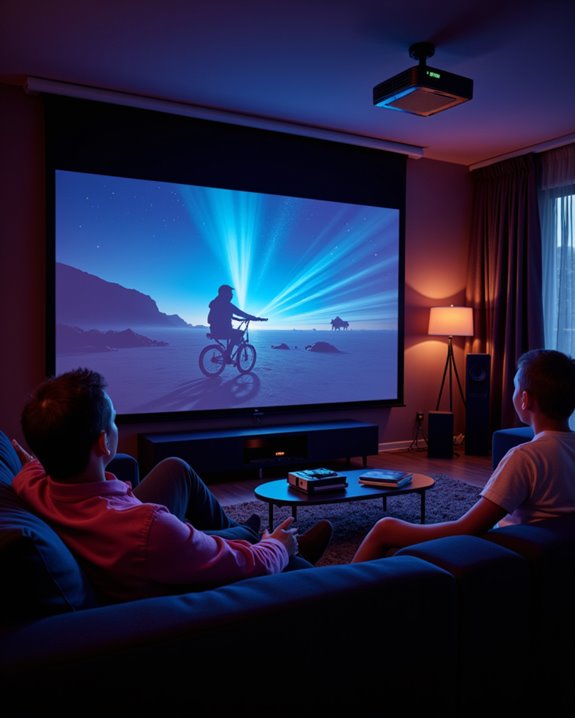
The home theater projector market demonstrates remarkable growth potential, driven by increasing consumer demand for cinematic experiences at home. Current market valuations show significant expansion, with global figures reaching USD 4,435.14 million in 2024 and projected to hit USD 6,726.27 million by 2031, growing at a steady 6.1% annual rate.
Consumer adoption is accelerating due to several key factors. Rising disposable incomes enable more households to invest in premium entertainment systems, while technological advancements make projectors more accessible and user-friendly. The introduction of ultra-short-throw and laser projectors has particularly influenced market growth, offering space-efficient solutions with superior image quality. Additionally, the proliferation of high-definition streaming services continues to fuel demand for enhanced viewing experiences, pushing consumers toward projector-based home theater setups. Major manufacturers like BenQ and Epson are leading innovation efforts by focusing on improving image quality through enhanced resolution, HDR capabilities, and color accuracy.
Indoor and Outdoor Entertainment Options
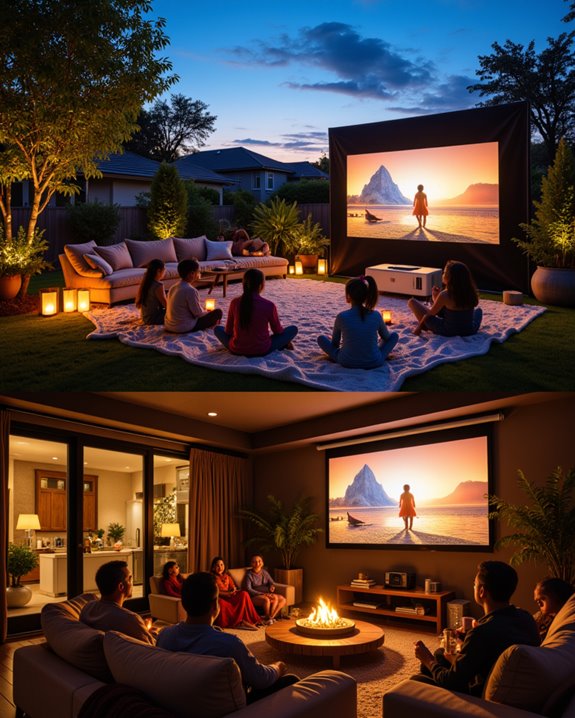
Modern home theater projectors extend entertainment possibilities far beyond traditional indoor viewing spaces. These versatile devices offer seamless progressions between indoor theaters and outdoor viewing areas, providing flexibility that standard TVs cannot match. Remote control operation and minimal screen maintenance requirements make setup convenient for various environments.
The adaptability of projectors allows users to create immersive viewing experiences across different settings. They can project onto various surfaces, from dedicated indoor screens to outdoor walls or portable screens, accommodating different event sizes and viewing preferences. Their lightweight design and portability make them ideal for both permanent home theater installations and temporary outdoor setups. Weighing in at only 2 lbs, some portable projectors are exceptionally easy to transport. Users can easily adjust screen sizes and positioning to match their space, whether hosting an intimate indoor movie night or a large outdoor gathering.
Frequently Asked Questions
How Long Do Projector Bulbs Typically Last Before Needing Replacement?
Like stars in the night sky, projector bulbs have varying lifespans. Traditional UHP and UHM bulbs require replacement after 2,000-4,000 hours, while modern LED and laser options extend bulb lifespan to 20,000-60,000 hours.
Can Projectors Effectively Display Video Games Without Significant Input Lag?
Modern projectors can effectively handle gaming latency, especially DLP models with dedicated gaming modes. Many achieve response times under 20ms, while projector responsiveness continues to improve with newer technologies designed specifically for gaming.
What Maintenance Is Required to Keep a Projector Running Optimally?
Like a car needing regular oil changes, projectors require consistent maintenance. Regular cleaning to prevent dust buildup, monthly air filter checks, timely lamp replacement, and proper lens cleaning guarantee ideal performance and extended equipment life.
Do Projectors Consume More Electricity Than Traditional TVS of Comparable Size?
Projectors typically consume more power than TVs of comparable size, with ranges of 50-800 watts versus 80-400 watts for TVs. However, modern projectors offer energy efficiency features like Eco-mode to reduce power consumption.
Which Screen Materials Work Best for Different Projector Types?
Like a perfect match made in heaven, screen durability and material reflectivity determine ideal pairings: Matte white suits DLP projectors, high-contrast gray works with LCD models, while ALR screens excel with UST projectors.

